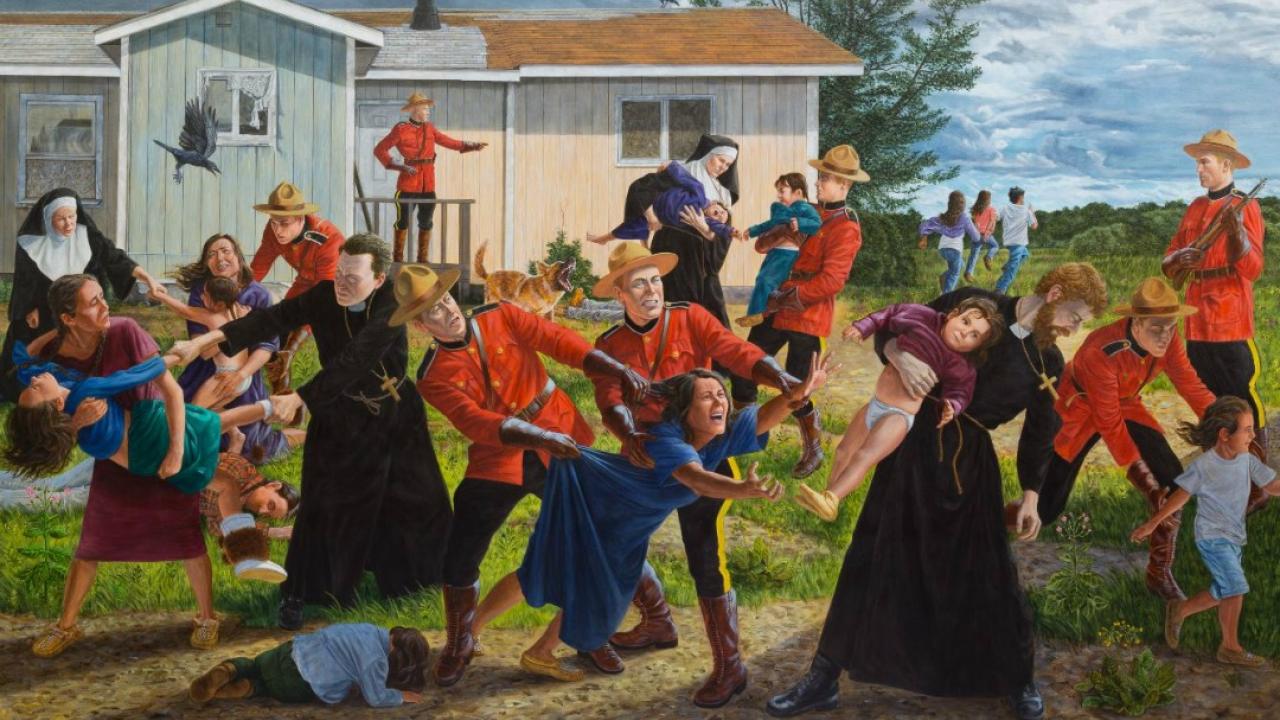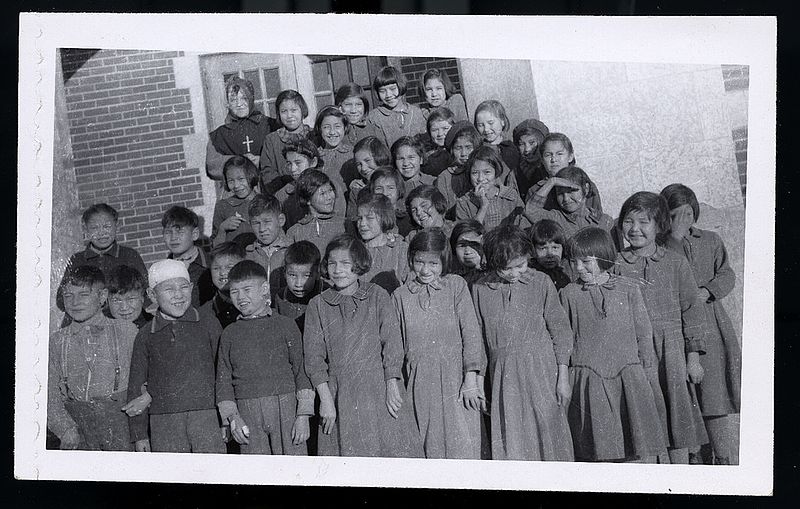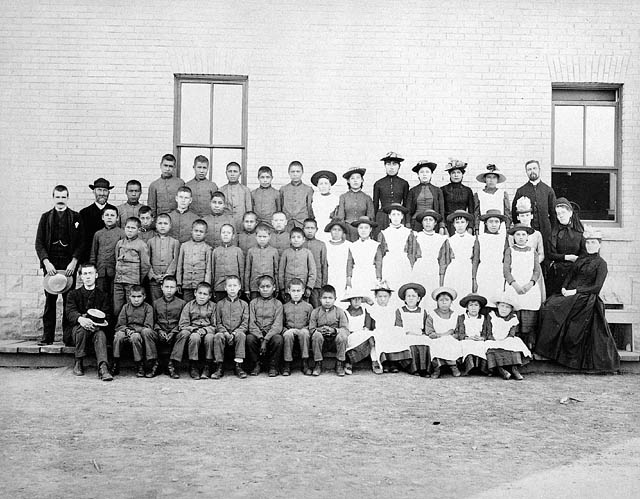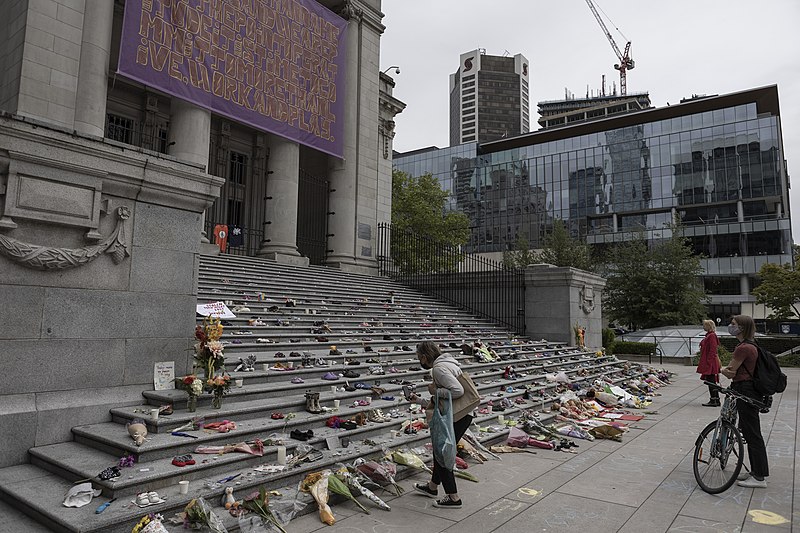A mass grave containing the remains of 215 children, some as young as three years of age, was discovered at the end of May on the grounds of the former Kamloops Indian Residential School in British Columbia, Canada. The grisly discovery, the result of a search organized by the Tk'emlúps te Secwépemc First Nation using ground-penetrating radar, confirms what the survivors and families of victims of the residential school system have known for years—that many of the children forced into these schools never returned home.
The crimes of colonization cannot be buried forever
The discovery of the mass grave has been met with justifiable anger, grief, and outrage. The Canadian government's response, with its typical crocodile tears and vague promises, only adds to the horror of the situation.
The Kamloops residential school was established in 1890 and run by the Catholic Church until 1969, when it was taken over by the federal government until it was finally closed in 1978. Abuse was rampant at the facility. The deaths of these children at the school went undocumented. Because of this, and the fact that more areas of the grounds of the Kamloops residential school need to be searched, it is entirely possible that further burial sites and bodies could be found.
While the mass grave at the Kamloops residential school is the largest such discovery to date, it is not the first unmarked grave to be found on the grounds of former residential schools. Over the decades, unmarked graves and cemeteries have been discovered, for example, in or near Regina and Battleford in Saskatchewan and near Cranbrook in British Columbia.
There was never an official policy from the federal government on how to handle the deaths of children at residential schools. The only policy really in place was that the Department of Indian Affairs refused to ship home the bodies of children because of the related costs. The result was that those that died at the residential schools were buried on or close to the grounds.
 The mass grave containing the remains of 215 children on the grounds of the former Kamloops Indian Residential School in British Columbia is a legacy to the crimes of colonization / Image: Public domain
The mass grave containing the remains of 215 children on the grounds of the former Kamloops Indian Residential School in British Columbia is a legacy to the crimes of colonization / Image: Public domain
The Truth and Reconciliation Commission (TRC), established in 2008 as part of the Indian Residential Schools Settlement Agreement (the largest class-action settlement in Canadian history), concluded its 2015 report by saying that, “Many, if not most, of the several thousand children who died in residential schools are likely to be buried in unmarked and untended graves.”
As was reported by The Globe and Mail, “The commission used satellite imagery and maps on a sample of school locations in an effort to locate unmarked gravesites, and found possible cemeteries ‘in a surprisingly large number’ of locations.” The TRC requested $1.5 million over a decade ago to search for unmarked burial sites at former residential schools, but the request was denied by the federal government under Stephen Harper.
While the TRC was able to confirm the deaths of 3,200 children at residential schools, estimates of the total death toll were initially around some 6,000 or more. The National Centre for Truth and Reconciliation, established after the TRC issued its report, has thus far confirmed the identities of 4,117 children who died after attending a residential school. Causes of death included disease (50 per cent tuberculosis), fires, and suicide, with many children dying of exposure while trying to escape.
However, these figures do not capture the full story. According to former senator Murray Sinclair, who chaired the TRC, the total number of deaths of children at residential schools could be as high as 15,000. This is because the Canadian government only allowed 139 schools to be part of the TRC, while in reality there were over 1,300 schools, run by various religious denominations and the provinces, in addition to those run by the federal government. These were not included in the TRC investigation or report.
What’s more, for just under a third of the 3,200 deaths confirmed by the TRC, there was no record of the name of the child who died. For around a quarter, there was no record of the gender of the child; and for almost half of them there was no record of the cause of death. Between 1936 and 1944 alone, 200,000 Indian Affairs files were destroyed.
The continuing legacy of colonialism
In response to the news of the mass grave in Kamloops, Prime Minister Justin Trudeau called the discovery “a painful reminder of that dark and shameful chapter of our country's history.” Trudeau’s hypocrisy truly knows no bounds. The residential school system was not simply a dark and shameful chapter in the history of Canada. The very foundation of Canada is rooted in the oppression, subjugation, and exploitation of Indigenous people, which continues to this very day. This “chapter” in Canadian history was never closed. We need only look at the struggles in Baffinland, of the 1492 Land Back Lane land defenders, the Mi’kmaq and the question of fishing rights, and the struggle of Wet'suwet'en to see this.
The Truth and Reconciliation Commission declared the residential school system an act of cultural genocide. The horrific discovery on the grounds of the Kamloops residential school is likely just the tip of the iceberg. As Assembly of First Nations National Chief Perry Bellegarde said, “Kamloops is one school. I’ve said before that the residential school system was a genocide against First Nations people, Indigenous peoples. Here is the evidence. Nobody can deny that.”
The residential school system was in fact part of a broader set of policies of genocide of Indigenous peoples over the centuries of colonization, not just in Canada but across the Americas. It is estimated that between 1492 and 1900, that there were approximately 175 million excess Indigenous deaths in the Americas, with a 95 percent reduction in their population during that period. Historian David Stannard has explained that the Indigenous peoples of the Americas underwent the “worst human holocaust the world had ever witnessed, roaring across two continents non-stop for four centuries and consuming the lives of countless tens of millions of people.”
The purpose of the residential schools
While the discovery of the mass grave in Kamloops is horrific, heartbreaking, and enraging, it should not come as a surprise. The existence of such mass graves has been an open secret for decades. Indigenous communities knew many of their children were not coming home. Survivors reported the rampant abuse and the deaths at the schools, but nothing was done. The federal government at the time knew that children were dying at alarming rates and was after a certain point paying for some of the burials.
From the 1870s until the last school closed in 1996, at least 150,000 First Nations, Métis and Inuit children attended residential schools in Canada. After 1894, attendance was compulsory for First Nations children. The purpose of the schools was not to educate, but to break Indigenous children’s link to their culture and identity. This is why the Truth and Reconciliation Commission concluded that the residential school system amounted to cultural genocide.
In a speech before Parliament in 1883, Canada’s first Prime Minister and a Father of Confederation, John A. Macdonald said:
“When the school is on the reserve, the child lives with its parents, who are savages; he is surrounded by savages, and though he may learn to read and write his habits, and training and mode of thought are Indian. He is simply a savage who can read and write. It has been strongly pressed on myself, as the head of the Department, that Indian children should be withdrawn as much as possible from the parental influence, and the only way to do that would be to put them in central training industrial schools where they will acquire the habits and modes of thought of white men.”
By breaking children’s link to their culture and traditions, the hope was to turn them into malleable wage labourers upon graduation, instead of relying on their traditional forms of survival. Many of the schools were specifically designed to force Indigenous children into agricultural and mechanical work, and were often called “manual labour” and “industrial” schools. Due to a severe lack of funding, residential schools often relied on the forced labour of the children attending for repair and maintenance. This forced labour was often brutal, interfered with any actual learning, and was presented as a positive thing in the form of “work training”.
The Indian Act gave Indian Affairs the power to forcibly remove children from their homes. Many children were kidnapped by state authorities—often by the RCMP, in partnership with the Church.
 The RCMP played a direct role in forcibly rounding up children to be taken to the residential schools / Image: Kent Monkman
The RCMP played a direct role in forcibly rounding up children to be taken to the residential schools / Image: Kent Monkman
The RCMP played a direct role in forcibly rounding up children to be taken to the residential schools. As one survivor explained: “One day [my parents] were out picking berries, and I was playing with two other kids in the front yard of the house... when an RCMP, a priest and two nuns came and just grabbed me out of the yard and threw me in a wagon. That's kidnapping. We had no say in those days.”
Spiritual and cultural practices were banned at the residential schools and the children were not allowed to speak their own languages. Students were also subjected to a forced assimilation plan, removing any tribal affiliation or treaty rights. In the classic tradition of bureaucratic double-speak, this process was known as “enfranchisement”. In a dehumanizing fashion they were referred to by numbers in many schools.
Punishment for misbehaviour was often brutal and abusive. There are reports of children being lashed, beaten, having their heads shaved, being locked in small confinement cells for weeks at a time, given diets of water and bread, and having their pants pulled down, and publicly shamed. Physical and sexual abuse was rampant. Poor health care and nutrition were the norm. Government and church officials were made aware of the problems numerous times and nothing was ever done to stop the abuse. This is because the abuse was both implicit and explicit in the design of the residential school system.
Returning home after years separated from their families, and unable to speak the language of their elders, students became alienated from their traditional communities. They did not receive the nurturing care that children need to develop healthy relationships in their adult lives, leading to cycles of violence and mental health challenges passed down from generation to generation, creating cycles of intergenerational trauma that continue to inflict and re-inflict wounds on Indigenous communities to this day.
In addition to the residential schools, there was also what is known as the Sixties Scoop, which was a continuation of the “kill the Indian in the child” policy that inspired the residential school system. As the Canadian government started phasing out the compulsory residential school system in the 1950s and 1960s, the Scoop was brought in. In 1951, provincial child welfare services were extended to Indigenous children. Instead of sending children to discredited residential schools, child protection officers seized Indigenous children in great numbers. These children often had their culture erased by being sent to non-Indigenous foster homes, where abuse was common.
Crocodile tears
In response to the discovery of the mass grave, Trudeau ordered that flags at federal buildings be flown at half-mast and promised “concrete action”. The Trudeau government has promised increased support for survivors of residential schools as well as the federal government’s help to preserve gravesites and find other unmarked burial sites on the grounds of other former residential schools. True to form, there are no concrete details attached to these promises of the Liberal government.
The federal government has already paid out more than $4 billion in compensation to victims of the residential school system. To give just an idea of the level of abuse at the residential schools, these claims involved nearly 38,000 cases of sexual or serious sexual assault among the 80,000 survivors alive today. The discovery of further mass graves and cemeteries and a proper forensic investigation of these sites will cost money - money the federal government will not want to spend - and the proper identification of victims will in all likelihood lead to further compensation claims. The federal government has already shown it is willing to spend a good deal of money obstructing survivors of residential schools from seeking compensation.
We need look no further than the issue of clean drinking water in Indigenous communities to see the value of promises from Trudeau and the federal government. Trudeau came to power promising to end boil-water advisories on reserves by March of this year. The government backed away from this promise and explained that advisories would now be lifted “as soon as possible”. It is an absolute scandal that these boil-water advisories cannot be resolved (there are currently 52 long-term advisories on reserves around the country), and that in some cases Indigenous communities have been waiting for repairs to their water systems for over 25 years.
In this year’s budget, the Liberals promised $18 billion over five years for Indigenous communities. This is a significant increase in funding from the $4.5 billion announced in the 2019 budget. After massive protests against the oppression of Indigenous people, the Liberals have decided to try to buy their way to peace. However, even this amount does not absolve the Liberals from their broken promise to end boil-water advisories on reserves. $1.7 billion is earmarked for reserve infrastructure, less than half the amount necessary to resolve the scandal, and there is no timeline for when all reserves will have drinkable tap water. Even more galling is the fact that, while the Canadian government continues to refuse to dedicate the funds to provide safe water, they were more than willing to spend almost double the cost to buy an oil pipeline that is being forced across Indigenous lands.
The Canadian state has repeatedly demonstrated that it is no friend of Indigenous communities. Despite decades of promises by the Canadian government, little has been done to improve the quality of life of Indigenous peoples on or off the reserve, or to repair the generations of trauma inflicted by the same state.
To give an idea of the levels of poverty in Indigenous communities, more than 80 percent of reserves have a median income below the poverty rate, and the median income for Indigenous people both on and off reserves is 30 percent lower than the rest of the population. Around half of First Nations children live in poverty. The incarceration rate for Indigenous people is 10 times higher than among the non-Indigenous population. Close to half of all the reserves in Canada require a new school, and over 40 percent of all homes on reserve are in need of urgent repairs.
The bourgeois politicians periodically cry crocodile tears for the missing and murdered Indigenous women, for the families who have lost their loved ones to suicide, and now for the victims of abuse at residential schools. Yet these same people sit on their hands and do absolutely nothing to address the underlying misery in Indigenous communities caused by the state’s own abuse and neglect.
Remember the dead, fight like hell for the living
The Ontario Federation of Labour (OFL) and the Alberta Federation of Labour (AFL) have called for a National Day of Mourning and Remembrance and for a search for other graves at other former residential school sites. Importantly, the AFL has also called for the “removal of the names of the architects of the system from schools and public buildings; and an inquiry into the current child welfare system, which continues to separate Indigenous children from their families and their culture.”
These demands are a good starting point, but more must be done. While the federal government and most of the churches responsible for the residential school system have offered formal apologies, the Catholic Church has refused to issue an apology, which would only be symbolic in any case. More importantly, the Catholic Church has refused to release documents related to the deaths of children and the unmarked graves at former residential school sites. The federal government also has documents that it has not released, and it has already fought against the release of documents in relation to the St. Anne’s case.
These documents will be an important part of any investigation into the deaths of children at residential schools and have a direct bearing on the case of the Kamloops residential school. For example, according to Mary Ellen Turpel-Lafond, director of the Indian Residential School History and Dialogue Centre at the University of British Columbia in Vancouver, when the Truth and Reconciliation Commission tried to find out what happened in residential schools, it was told that only 50 deaths occurred at the Kamloops school.
 We will probably never know exactly how many children died at the Residential Schools / Image: public domain
We will probably never know exactly how many children died at the Residential Schools / Image: public domain
The crimes and abuses committed at residential schools are not ancient history. The last school only closed in 1996, and the Kamloops school in particular only closed at the end of the 1970s. Firstly, Indigenous communities themselves must be in charge of any and all investigations. Indigenous communities and the broader labour movement must stand together and demand the release of all documents by the Catholic Church and governments at all levels and demand that those responsible for these abuses and crimes, both individuals and institutions, are prosecuted and held accountable.
We cannot limit our struggle for justice and Indigenous liberation to the question of residential schools. Any disputed pipeline, mining, and housing complex projects that encroach on Indigenous lands and rights must be stopped immediately. The money spent on these projects must be used to end the boil-water advisories and to resolve the deep infrastructural crisis in Indigenous communities. The money spent on all of the corporate projects could pay for the repairing of all water systems as well as houses, medical facilities, and schools, all of which are severely underfunded in Indigenous communities.
Unceded traditional territories should be acknowledged and returned to the relevant Indigenous communities immediately. In cases such as the struggle of Haudenosaunee, we must fight for an end to the police harassment of 1492 Landback Lane. All this stolen land and land promised should be returned to the Haudenosaunee and all other communities in similar land disputes without delay.
The solidarity of workers at the Baffinland Iron Mines Corporation with their Indigenous brothers and sisters shows us the way forward. These sentiments of solidarity with the Indigenous struggle need to be further developed by the labour movement. The Indigenous struggle is innately anti-capitalist, and an inherent part of the class struggle in Canada. Every instance of struggle we have witnessed in the past few years has been Indigenous actions against a private corporation encroaching on their land. These are the very same capitalists against whom the wider working class are struggling. Any labour action in opposition to corporate developments would only strengthen the struggle against the continued exploitation and oppression of Indigenous peoples. In order to make this a reality, the labour movement must firmly link up with the struggle waged by Indigenous people.
 After centuries of exploitation, genocide, and abuse, there is no possibility of reconciliation between Indigenous peoples and their exploiters. The capitalist system must be overthrown / Image: public domain
After centuries of exploitation, genocide, and abuse, there is no possibility of reconciliation between Indigenous peoples and their exploiters. The capitalist system must be overthrown / Image: public domain
The capitalist state cannot allow any meaningful reconciliation to take place, as this would fundamentally undermine the interests of the capitalist class. Small gestures and tearful apologies cannot reconcile Indigenous people with all that has been taken away from them. Even as the faces of the capitalist class change, the reality remains the same. As Trudeau has repeatedly demonstrated, reconciliation is but a distraction while Indigenous rights continue to be trampled and massive profits continue to be made.
So long as the Canadian state remains under the control of the capitalists, their relentless drive for profits from the exploitation of Canada’s land and resources will continue. The ensuing disregard for Indigenous land and treaty rights represents an irreconcilable contradiction between the Canadian state and Indigenous peoples. This capitalist state must be overthrown. This is the same state that represses not just Indigenous peoples, but all workers and oppressed in Canada. Unity of the workers and oppressed is a key component of overthrowing the capitalist state. Through unity of Indigenous and non-Indigenous workers and respect for Indigenous sovereignty, land, and resource rights, Indigenous people would finally be empowered to democratically determine their own fate. Together, we could build a socialist society based on democratic control from below for the satisfaction of human needs rather than the exploitation, profit, and environmental destruction of capitalism.
After centuries of exploitation, genocide, and abuse, there is no possibility of reconciliation between Indigenous peoples and their exploiters, the capitalists and their Canadian state. As long as capitalism continues to rule the land, these crimes will continue. The way forward to the genuine liberation of Indigenous peoples is class unity and the fight for our socialist future. If we stand firm in our class unity, and if we commit to remembering the dead and to fighting like hell for the living, we can overthrow this rotten system.

